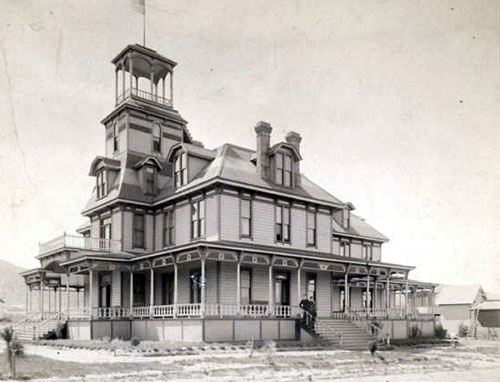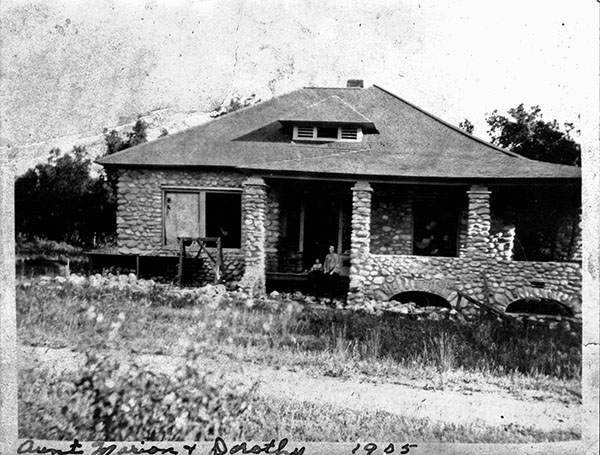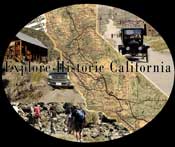|
For
nearly thirty years I have known of the historic Rowley House in my
neighborhood of Sunland/Tujunga. In the past ten years it finally
dawned on me that the magnificent rock house I regularly passed on
the backroads to the Sunland post office was the same one pictured
in my local history books. Somehow I missed the year it was offered
on our historic house tour. In the last year, I have been given a
personal glimpse into the past and present of this wonderful home,
thanks to newfound friendships. This is the first in a series about
the house and the hardy and often boisterous pioneers who called it
theirs in the early days of what was then known as Monte Vista
Valley.
It was 1882 when the Rowley brothers first wandered up to
the hills of Tujunga north of the City of Los Angeles. The buckboard
was loaded with bee hives as they drove through washes and logging
roads looking for a place to homestead and farm. Their first home
was a tent, complete with their bees and one horse, on 160 acres in
the area now known as Seven Hills.
|
 |
| 1915
map view of Monte Vista (now Sunland-Tujunga)
valley located above the center of the map, east of San
Fernando and north of Burbank.
(Map courtesy Library of Congress collection) |
The Rowley family came to California from Minnesota looking
for an escape from the depression that had hit the Midwest so hard
after the Civil War. The bright brochures and colorful posters
promoted by the railroads lured many families to the rich farm lands
and milder climates of Southern California. The promise of
government land and a new life, combined with cheap rail rates to
get there, called to the Rowley boys as well. Loron Rowley
purchased a Southern Pacific ticket and joined two brothers in
Mandeville Canyon (Hollywood Hills) raising bees and selling honey.
In 1882, he found his own land in the Monte Vista Valley. With the
help of the original Verdugo family of California’s Rancho fame, he
was able to build a ranch house on homesteaded acreage.
In addition to beehives, Loron raised cattle and found a
market for the wood on his property. The ever growing City of the
Angeles some fifteen miles away, needed wood for steam boilers, heat
and cooking. An abundant supply of greasewood and pine trees of the
foothills of the San Gabriels provided a lucrative business.
By the 1890’s, the wood played out and the forests were in
need of replenishing. Loron struggled with his cattle and beehives
until the land developers and promoters arrived. In 1885 he signed
on to help build a two story structure on the southwest corner of
Central Avenue and First Street (now Fenwick and Oro Vista). The
building was used for mail distribution and a general store that
sold everything from crackers to coal oil. Loron’s freight and mail
service helped connect the early Sunland Tujunga pioneers to the
outside world and kept them in supplies they could not raise or hunt
themselves.
The great boom that brought Loron and his brothers to Monte
Vista Valley began to collapse in 1888. Many original land and
building prospectors moved and went on to other ventures. Loron’s
businesses and services suffered with the downturn. During this
time, Loron met his future wife, Virginia, who came to tame a rowdy
and struggling schoolhouse.
Loron also sent for more of his family. Father, Asa Rowley,
and his sister, Mary Grace homesteaded on land near by. The bees and
honey continued to thrive, but olive groves, peach orchards, and
alfalfa replaced the family cattle.
The Rowley homesteads grew to 1,000 acres over the years,
as they bought or quitclaimed land at the base of the mountains from
Big Tujunga Canyon to neighboring La Crescenta.
Following a two year courtship, Loron and the bold school
teacher, Virginia Florence, married. The year was 1893, and the
ranch against the hills became the new Mrs. Rowley’s home. Virginia
continued to teach at the now orderly school, as well as tending to
her home garden, and helping with her husband’s various enterprises.
In 1896 she gave birth to their first son, Eustace.
Sometime in the 1890’s, the little family was encouraged, by Loren’s
brother Dr. Quentin Rowley, to live in the fading Monte Vista Hotel
he had bought as an investment. They watched over the hotel closer
to the town center, managed the ranch and enlarged the family.
Robert Rowley was born in 1898 at the hotel, and Dorothy came along
in 1902.
 |
|
The
Monte Vista Hotel, 1886.
(Photo courtesy CSUN/ San Fernando Valley History
Digital Library) |
In 1903, Dr. Q. Rowley sold the Monte Vista Hotel, and
Loren, Virginia and children were back at the ranch house. The boys
were in school with a two mile hike every day to get there.
By 1905, the Rowley family built the first rock home
in Monte Vista on Hill Avenue near Flower Street (now Hillrose and
Floralita).
 |
|
The
Rowley House, 1905. Inscription reads, "Aunt Marion &
Dorothy 1905."
(Photo courtesy Rowley House collection) |
Not only was it easier for the children to get to school,
they were closer to community businesses and Loren’s endeavors
beyond ranching and farming. Virginia moved her flock of chickens
and her vegetable garden to the backyard behind the stone house. An
adjacent pasture was perfect for the family horses and milk cows,
with a running spring to keep the ground damp and the grass green
all year round.
The Rowley house was quick to become a home, with two more
children joining the family as the years went by. Virginia managed
to take care of children and both the Hill St. house and the family
ranch. She also took over as postmistress, and helped Loren with the
general store, freighting, and more.
At an early age the children pitched in where needed, at
home or one of the family businesses. Loren and Virginia made sure
they were well schooled, and received formal music lessons. Evenings
they were seen on the big front porch playing games, and practicing
their musical instruments. Weekends were large homegrown dinners,
with Sunday’s reserved for Free Methodist church services. The
entire family had a large presence in the foothill community, and
was well known.
To be continued...
Bibliography
From Crackers to Coal Oil
by Mary Lee Tiernan
The Early History of
Sunland, California, Voume IV
Snoops Desktop Publishing
Sunland, California 91040
Founding sisters - Life Stories of Tujunga’s Early Women Pioneers
1886-1926
by Mary Lou Pozzo
Zinnia Press
Tujunga, California 2005
Rancho Tujunga
A History of Sunland/Tujunga, California
Compiled by Sarah R.
Lombard
Published by Sunland
Woman’s Club
Produced by Bridge
Publishing
Burbank, California
Sunland and Tujunga From Village To City
by Marlene A. Hitt
Little Landers Historical
Society
Arcadia Press, 2002
Monte Vista Valley
map courtesy Library of Congress
Online Exhibition
http://www.loc.gov/exhibits/lamapped/lamapped-exhibit.html
Monte Vista Hotel photo courtesy San
Fernando Valley History Digital Library Collection
http://digital-library.csun.edu/SFV/
Special thanks to the
current residents of the Rowley House for graciously sharing their
personal archives with us.
NOTE: According
to Sarah Lombard various old maps show “Tuhunga” on the Southern
Pacific Railroad, near Little Tujunga Canyon. An early post office
was located between the town of San Fernando and the confluence of
Big and Little Tujunga Rivers. There was a post office established
in “Tuhunga” on January 5, 1885 through March 3, 1894.
The first post master was
J. S. Florey. Mail was received from San Fernando by Rural Free
Delivery after 1894. The actual town of Monte Vista (now Sunland)
was platted in March 1885. Sherman Page and F. C. Howes were
responsible for sales of lots and acreages for farms
|
